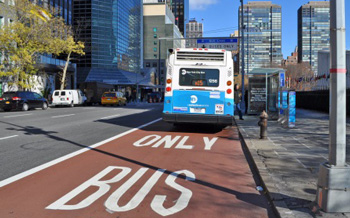
A dedicated bus lane. Image Credit: NYC DOT
The changes affect four bus lines connecting ten major subway lines in the Bronx and Manhattan. On October 9, 2020, Mayor de Blasio announced major bus and bike improvements in the Bronx furthering the Better Buses Restart plan and keeping the City on track with de Blasio’s recovery agenda.
Announced in September 2020, the recovery agenda focuses on public health and social justice. The agenda is centered around four principles to make the City stronger, healthier, and fairer:
– Continue the City’s momentum in fighting back COVID-19
– Make the City a hub for public health research
– Create high-quality jobs
– Continue making New York the fairest city in America
The Better Buses Restart plan aims to increase bus speeds and reliability and includes the following goals:
– Improve 5 miles of existing bus lanes every year
– Install 10-15 miles of new bus lanes each year
– Pilot up to 2 miles of physically separated bus lanes
– Implement Department of Transportation street design projects that benefit 600,000 daily riders each year
– Add 300 Transit Signal Priority Intersections per year
– Expand the bus lane camera enforcement
– Increase NYPD bus lane enforcement with seven dedicated tow truck teams
– Evaluate and improve bus stops
– Support MTA Bus Network Redesign efforts with borough bus priority plans
– Press for all-door boarding, restarting the Select Bus Service program, and other improvements to bus operations.
The newest improvement is the fourth bus-priority project completed since Mayor de Blasio announced the Better Buses Restart plan in June 2020. The 149th Street Bus Priority, running 2.7 miles from Southern Boulevard to River Avenue, serves 55,000 daily passengers. The corridor carries four bus routes — the Bx2, Bx4, Bx17, and Bx19 which connect to ten subway lines in the Bronx and Manhattan and major community destinations such as Hostos Community College, Lincoln Medical Center, and The Hub. The 149th Street Bus Priority project included installing red-painted offset bus lanes, pedestrian islands, turn bays, and loading zones in order to combat major issues such as congestion, slow bus speeds, double parking, and unsafe weaving and merging. Previous congestion on 149th Street resulting in buses moving at speeds as slow as 4 mph caused major backups along the entire route, sending buses off schedule or causing two or three buses to arrive simultaneously. Bus lane enforcement cameras were also installed along 149th Street, and for the next 60 days, drivers will receive bus lane violation warnings. After the 60 days, bus lane violations will be issued starting at $50 and can escalate to as high as $250 for a fifth violation in a one-year period.
Mayor de Blasio, in partnership with Lyft, also announced that Bronx cyclists have logged nearly 100,000 Citi Bike trips to and from over 100 newly installed docks since installation began this spring. To date, the Bronx now has 110 Citi Bike docking stations, stretching from the South Bronx up to the Cross Bronx Expressway and from University Avenue to Southern Boulevard. The Department of Transportation will continue to work with Lyft, Citi Bike’s parent company, to expand the Citi Bike program into most of the borough within three years.
Speaking about the project, Mayor de Blasio said: “The Bronx deserves faster and more reliable transit options. From faster buses to more bike infrastructure, we’re determined to use this crisis to deliver it … and we’re excited to continue expanding transit options in the future.”
By: Lynsey Smith (Lynsey is the CityLaw intern and a New York Law School student, Class of 2022.)

